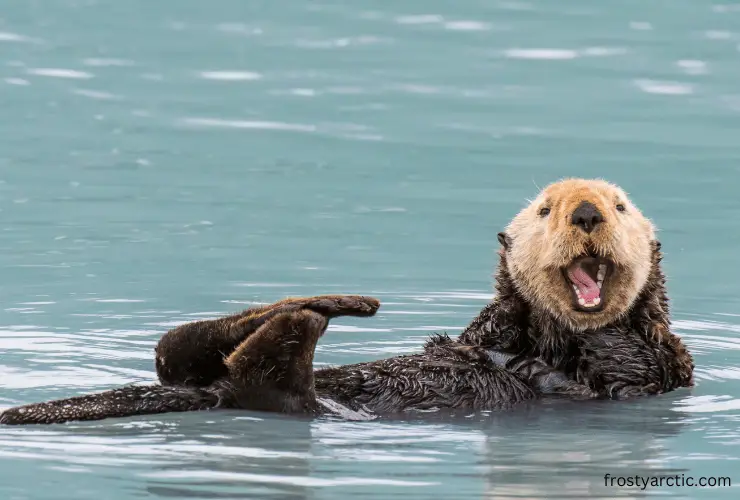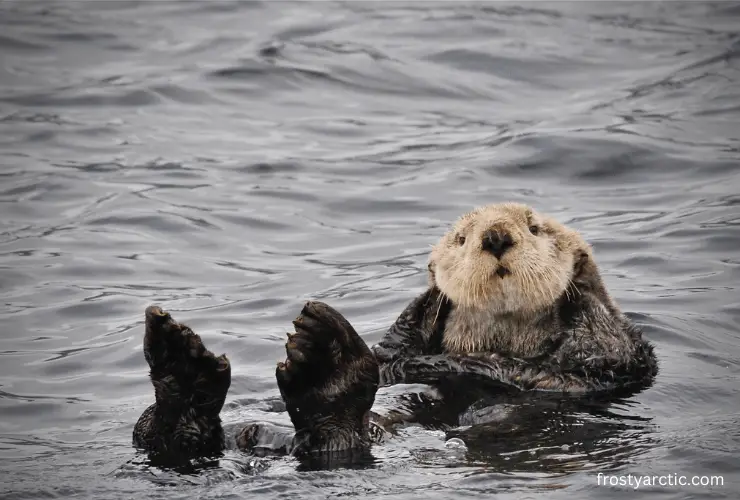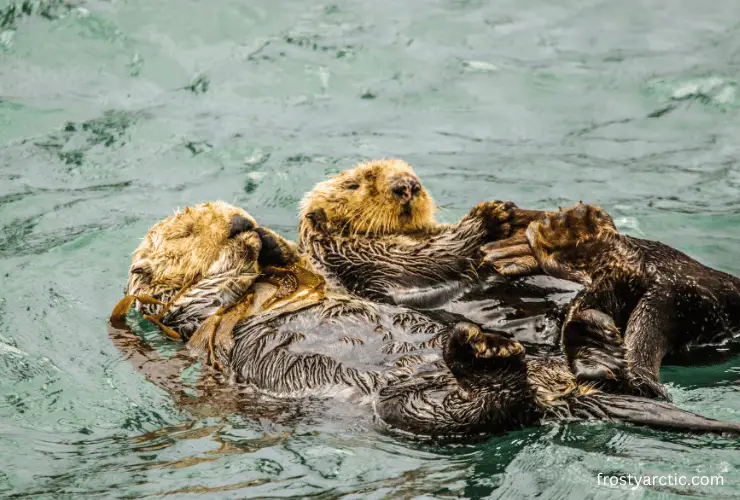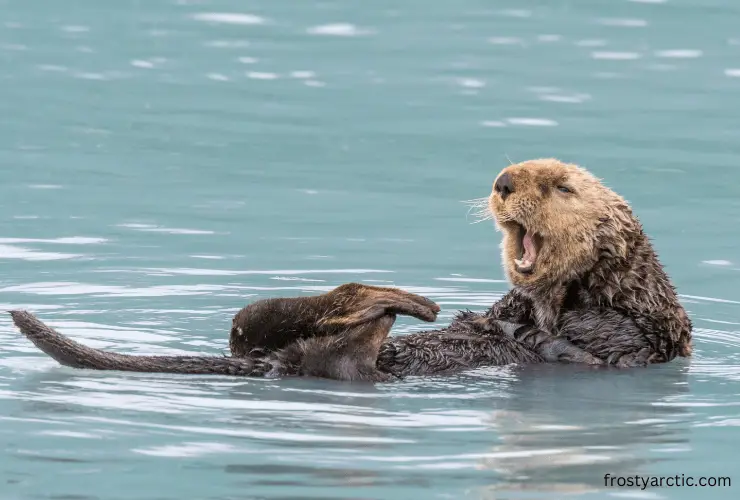Sea otters communicate primarily through vocalizations, body language, scent markings, and physical contact. Each otter’s vocalization is unique. They make different sounds, such as squeals, grunts, and whistles, to express emotions or warn others of danger. Scent marking, specifically through their feces, known as spraints, plays a key role in territory differentiation and identification.
Have you ever wondered, ‘Why do sea otters communicate?’ Sea otters are inherently social, and communication forms a significant part of their social structures. It helps express emotions and intentions, establish territory, and dominance, coordinate group activities, and foster parent-offspring interaction.
Read this article to uncover the amazing secrets behind their communication. We’ll explore how they interact with each other and other species and even how they communicate underwater.
Why Do Sea Otters Communicate?
Sea otters are incredibly social creatures, and communication plays a pivotal role in their social structures.
● Expressing Emotions and Intentions
They use communication to express their emotions and intentions to each other. Different vocalizations and physical cues can signal whether an otter is afraid, angry, playful, or looking for a mate.
This variety of emotional expressions through communication aids in maintaining social harmony among otters in a group known as a raft.
● Establishing Territory and Dominance
Territorial claims and dominance assertions are other important reasons why sea otters communicate. Male otters, in particular, use scent markings to stake their claim on territories and to signal dominance over others. These messages stop opposing otters from invading the territory, helping to prevent conflicts.
● Coordination of Group Activities
These mammals also communicate to coordinate group activities, such as foraging or grooming. They use specific sounds and signals to alert others in the raft about food availability, approaching predators, or other immediate concerns.
● Parent-Offspring Interaction
Parent-offspring interaction is another critical area where communication comes into play. Mothers use certain sounds to call their pups, warn them of danger, or guide them in learning essential survival skills.
How Do Sea Otters Interact Each Other?

Sea otters use a blend of vocal, visual, tactile, and olfactory methods of communication to interact with each other.
● Vocalizations
Vocalization is a significant mode of communication among these aquatic creatures. They use a range of sounds like chirps, growls, whistles, and even screams to communicate different emotions, intentions, or alerts. For instance, adults might growl or hiss to signal aggression or assert dominance.
● Body Language
Body language is another powerful form of communication for otters. They employ various postures, movements, and facial expressions to send signals to their fellow otters.
Aggressive or submissive postures, playful antics, or mutual grooming activities all provide valuable cues about their intentions or emotional states.
As per the insights shared in the Encyclopedia of Marine Mammals, sea otters often engage in quick side-to-side movements of their heads. These visual displays could convey various types of information, such as communicating social status, reproductive status, or other relevant details.
● Tactile Communication
These furry creatures are known for their tactile communication, which involves physical contact like touching, nuzzling, or grooming each other. These interactions often play a role in social bonding, comfort, and maintaining group harmony.
A mother otter, for example, might hold her pup tightly to her chest, a tactile gesture providing warmth, safety, and a sense of security to the young one. ~ Source
● Scent Markings
Scent marking is a form of communication commonly seen in many animal species. In sea otters, this type of olfactory communication plays a vital role in their social structure and interactions, according to Otters: Ecology, behaviour and conservation (Oxford, 2006).
Male otters, in particular, use scent marking to convey information to other otters. This is usually related to territorial boundaries or dominance hierarchies within their group. By marking a particular area with its own unique scent, they send a clear message to other sea otters that the territory is occupied, thus helping to prevent conflicts and intrusions.
They have special glands, known as anal sacs, which produce a distinctive scent. These sacs secrete an oily substance that the sea otters spread throughout their fur during grooming. By doing so, they effectively ‘wear’ their scent, marking any area they inhabit with this unique signature.
What Kind of Sounds Does a Sea Otter Make?

Let’s take a closer look at sea otters’ sounds and what they mean.
● Distress Calls
When a sea otter is alarmed or distressed, it may emit a high-pitched scream or a sharp barking sound. For example, a mother otter or pup will scream if separated from one another. According to an article published in the Journal of Mammalogy, this scream is so loud that it can even be heard by humans as far as a kilometer.
● Warning Sounds
If a sea otter perceives a threat, it may emit a hissing sound or a loud “haa-haa” as a warning to other otters. These sounds can also be used to deter potential predators.
● Social Sounds
During social interactions, sea otters make a variety of sounds, including coos, grunts, and whines. They use these sounds for various purposes, such as greeting each other, expressing contentment, or initiating play.
● Foraging Sounds
While foraging, otters may make soft grunting or chirping sounds. These sounds may help to coordinate group foraging activities or signal the discovery of a food source.
How Do Sea Otters Communicate with Humans?
Like many wild animals, sea otters generally keep a distance from humans in their natural habitats. However, in captivity, they can become comfortable around human caregivers and display distinct forms of communication.
● Recognition and Bonding
These marine mammals in captivity have been known to recognize their human caregivers and form bonds with them. They display a certain level of comfort and trust toward the humans they interact with regularly. This familiarity is often shown through eye contact, approaching the human caregiver, or responding positively to their presence.
● Vocalizations and Body Language
Sea otters use vocalizations and body language to communicate their needs or emotions to their human caregivers. For instance, a hungry otter might make certain sounds or movements that, over time, the caregivers understand as a request for food. Conversely, an otter might hiss or growl to indicate discomfort or stress. ~ Source
● Behavioral Training
Many otters in captivity undergo behavioral training, where they learn to respond to certain signals or commands from their caregivers. This form of communication is crucial for medical examinations, feeding, and general care.
For instance, otters may be trained to respond to hand signals for different activities, such as presenting a paw for a health check or following a target for exercise.
How Do Sea Otters Communicate Underwater?
Sound travels faster and farther beneath the water than in the air, making it an effective means of communication. Like other marine mammals, sea otters are adapted to take advantage of this.
They have sensitive hearing and can produce and perceive a range of vocalizations. These include chirps, whistles, and growls, which help them communicate with others in their group. These sounds can vary in pitch and duration, each conveying different messages or emotional states.
They can also communicate with visual signals, including body postures and movements. Aggressive or defensive displays, such as showing teeth or certain swimming patterns, can serve as warning signs to others.
Research suggests that sea otters may also use water vibrations to communicate. Although not as well-studied as other forms of communication, it is thought that movements through the water can create vibrations that other otters can sense.
How Do Sea Otters Hear?

Hearing is a crucial sense for sea otters, enabling them to detect predators, communicate with their raft, and navigate their aquatic environment. These marine mammals have unique auditory adaptations allowing them to hear effectively both above and below the water.
● Structure of the Ear
Sea otters possess small external ears, known as pinnae, which can close when the otter dives to keep water out. Internally, they have a typical mammalian ear structure with an outer, middle, and inner ear, each playing a role in the hearing process.
The middle ear contains three tiny bones that transmit sound waves to the inner ear, which convert into nerve impulses and transmit to the brain. ~ Source
● Hearing Above Water
On land or at the water’s surface, sea otters rely on their acute hearing to detect potential threats or to communicate with other otters. They are particularly sensitive to high-pitched sounds, including many vocalizations sea otters use for communication.
● Hearing Underwater
Underwater, sea otters depend on their sharp hearing for survival and communication. They can perceive sounds, including the calls of other otters, the approach of predators, or the sounds made by potential prey.
How Do Sea Otters Make Sound?
Like other mammals, sea otters make sounds through their vocal cords in the larynx or voice box. The vocal cords are essentially two bands of elastic muscle tissue on the apex of the windpipe.
When the otter chooses to make a sound, air from the lungs passes over the tightened vocal cords, causing them to vibrate and produce noise. The pitch and volume of the sound can be modulated by adjusting the tension of the vocal cords and the amount of air pushed out from the lungs.
For instance, when the vocal cords are tightened, and the gap between them is small, the sound produced tends to be high-pitched. Conversely, relaxed vocal cords tend to produce deeper or lower-pitched sounds.
Moreover, the otter can alter the sound by adjusting the shape of its mouth, lips, tongue, and nasal cavity – similar to how humans form different words.
FAQs
Q: Are Sea otters vocal?
A: Yes, sea otters are indeed very vocal creatures. Their social structures and day-to-day interactions necessitate a broad range of sounds and vocal signals. In fact, researchers have documented nine distinct vocalizations that sea otters use in various contexts.
Q: What information can be conveyed through sea otters’ scent?
A: A sea otter’s scent can convey a wealth of information about that individual. This can include their sex, reproductive status (whether a female is in heat, for example), health condition, and possibly even their individual identity.
Q: Why do sea otters scream?
A: Sea otters may scream to express alarm or distress. For example, a pup might scream if it’s separated from its mother, or an adult might scream if it perceives an immediate threat.
Q: What sound do sea otters make when happy?
A: When Sea otters are happy, they may make soft, cooing sounds. This is often observed during times of play, relaxation, or grooming.
Conclusion
So, how do sea otters communicate? As we’ve discovered, sea otters utilize a broad range of vocalizations, body language, scent markings, and physical contact to communicate. It helps them to share essential information, exhibit emotions, assert dominance, and nurture social bonds within their communities.
Their skill in effective communication enables them to survive and thrive in their aquatic habitats. We hope you enjoyed reading the blog. Stay tuned for more otter-ly-filled adventures!



2 thoughts on “How Do Sea Otters Communicate?”